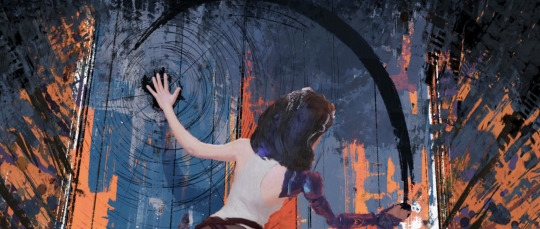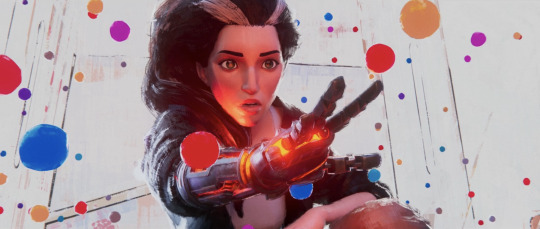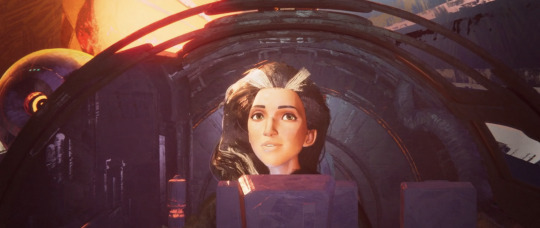Text
Edgin and the Dragonfly
*Spoilers ahead for DnD: Honor Among Thieves*
I have a lot of love for subtle, well executed storytelling like the blue dragonfly that shows up throughout Edgin’s arc. The editing in that death/resurrection scene really sells the emotion beyond the literal content of the scene while placing trust in its audience to make the connection. I appreciate the symbolic meaning behind the dragonfly, but my little gremlin brain can’t help but take it one step further and wonder about its literal presence within the world of the movie. Even if it is not meant to be the same individual insect, the timings of the blue dragonfly’s appearances seem too perfect to be a random (e.g. dancing on the flames of Zia’s funeral pyre, landing on Edgin’s forearm after Holga passes). It’s almost as if it is following Ed around.
On the way to the Orifice, Xenk offers Ed some wisdom on the subject of resurrection: “I’d only ask that you consider that this plane we call ‘life’ is but one of many. To drag your lady love back to her old life is to deprive her of her new one.” This is a great character moment that also delivers an important piece of worldbuilding: when people leave the material plane through death, they are reincarnated or otherwise continue their existence on a different plane. You may see where I’m going with this.
Enter the Zia-Dragonfly extraplanar visitor hypothesis. Yes, the name could use some work. It is already widely accepted that the dragonfly is a visual representation of Zia living on in Ed’s memories. In addition to this reading, I propose that the dragonfly may be a subtle physical manifestation of Zia’s extraplanar influence within the world of the story. Even if she cannot physically return to the material plane, something about her new existence may allow her to visit or influence it in a small way. If true, then the recurring appearance of the blue dragonfly has sentient intention behind it, with Zia selecting this form for her messenger to evoke a specific memory in Ed and communicate its associated life lesson at key moments. This would provide a diegetic explanation for why the dragonfly appears when and where it does while offering Zia’s character more agency in the narrative in a way that feels appropriately subtle, yet satisfying.
Anyway, if you want to go all the way with this hypothesis and say that Zia sent the blue dragonfly back in time so that she and Edgin would have that interaction to prepare him for her death and his whole emotional journey thereafter, then I support you.
37 notes
·
View notes
Text
Honor among thieves was a lot of fun and the comedy and action were on point, but my favorite part might have been the storytelling involved with Edgin’s development.
We get his backstory right away and it’s the typical death of a loved one dnd backstory but it’s told from his own self aggrandizing storytelling. And even then we have that small shot of him looking at the dragonfly. We as an audience have no idea why that is significant and you most likely forget about it because of the fast pace but it sticks in the back of your mind.
Then we have the next time we focus on the dragonfly and it cuts to his dead wife, and it appears to be the classic dead wife flashback with the bright sunbeams and nebulous white fabric. We now have a connection between the two solidified but we don’t know it means something yet.
Then in the pivotal point in the second act where the plan seems to be going to fail he has a dream and we have an explanation for the dragonfly as an image. It’s letting go, and not trying to force his life to be how we envisions it. And in this dream it reveals the shot of her from earlier wasn’t some generic image or even just them being in love but part of a specific memory Ed hasn’t wanted to think about. Plus moments later it is revealed how he was even more at fault for what happened and recontextualized a moment from the very beginning.
Finally at the end we don’t need a repeat of the flashback from earlier to know he is going to learn his lesson and let go. All we need is to see that dragonfly and we know what that means. It’s so perfect because it we as an audience feel exactly as he is. We’re remembering that specific memory based off being reminded by the dragonfly and so is Ed.
The dragonfly is a perfect visual representation of a nagging thought, something that floats up occasionally and he has been ignoring for a long time, but finally acknowledges by the end. Plus it is completely diegetic and introduced gradually and not overly telegraphed.
2K notes
·
View notes
Text
I just finished the last episode of Star Wars: Visions II and I gotta say, there wasn’t a single episode that didn’t amaze me in its own way. Inviting studios from around the world to tell their own independent stories breathes an incredible originality and authenticity into the universe. That different peoples can take the stories and world of Star Wars, find their own meaning through synthesis with their own lived experiences, then harness that emergent creativity to put work back into the universe exemplifies what I see as the true strength of fictional universes as shared narratives: its capacity as kind of modern mythology, a wellspring of themes, ideas, and relationships that people can find themselves in and use as a framework to tell their own stories. Visions is a testament to that inherent potential. The resultant diversity of stunning animation and powerful storytelling just fills my heart with joy and hope.
Star Wars belongs to everyone. At its core, it has always been about solidarity, connection, and hope persevering in the face of overwhelming darkness, and how positive change is contingent on their presence. I am grateful this show grants me the opportunity to experience what that looks like through other people's eyes, sharing their own sociocultural perspective and weaving it into a unique vision of what Star Wars is.
23 notes
·
View notes
Photo



“Light and darkness are part of the painting. Part of me.”
Not Star Wars: Visions giving us a visually stunning, beautiful representation of a person using art therapy to understand, heal, and grow from past psychological trauma. I love that it’s not just an aesthetic choice, but an integrated part of her emotional, thematic journey. It gives her the perspective and the strength to break free from life chosen for her by her former Sith master (read: abuser) and carve her own path, liberating herself physically and psychologically from his influence.
“I am the master now, and I can paint my own destiny.”
#art therapy#star wars#star wars: visions#sith#star wars day#may 4th#may the fourth be with you#star wars visions#visions 2#sith critical
99 notes
·
View notes
Photo



same energy
#they're all emotional manipulators#star wars: visions#screecher's reach#really captures the children's book eldritch horror of coraline#sith#sith mother#daal#star wars visions#coraline#other mother#shadowweaver#adora#she ra#she ra and the princesses of power#cartoon saloon#sith critical
324 notes
·
View notes
Photo

CW: abuse
To me, the Sith have always been about power, about manipulation, about abuse. They offer false hope as a lure to ensnare people when they are at their most vulnerable. They offer you what you think you need while gutting your support system, isolating you from those who could pull you back above water. Before you know it, the decisions you say you are making are no longer your own. And so, the visually brightest scene of the episode becomes its darkest moment thematically.
I am amazed that Star Wars continues to tell meaningful, complex stories about survivors, those who are able to liberate themselves from the confines of interpersonal and systemic abuse, as well as those who are unable to break free... yet.
This is why hope is so fundamentally important, not just in Star Wars or in storytelling, but in the real lives we lead. There is always, ALWAYS hope.
And may the Force be with you.
#star wars#star wars visions#star wars: visions#hope#sith#sith mother#screecher's reach#cartoon saloon#may the fourth be with you#may 4th#star wars day#visions 2#meta rambling#sith critical
703 notes
·
View notes
Photo

Apotheosis / Abduction
Star Wars: Visions - S2E2 “Screecher’s Reach”
#star wars#star wars: visions#screecher's reach#every frame a painting#may the fourth be with you#star wars day#may 4th#cartoon saloon#sith#star wars visions#visions 2
268 notes
·
View notes